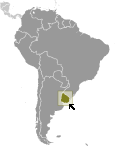World Atlas: Uruguay. On this page you can see the map, country flag and many detailed information about the people, history and economy of Uruguay.

Here you can find online selected information about the geography, inhabitants, government, economy and history of Uruguay. Included are selected statistics, an overview map and the detailed map of Uruguay. But let's start with the flag of Uruguay here:
Uruguay - Overview:
What you should know about Uruguay? Let's start with this: Montevideo, founded by the Spanish in 1726 as a military stronghold, soon took advantage of its natural harbor to become an important commercial center. Claimed by Argentina but annexed by Brazil in 1821, Uruguay declared its independence four years later and secured its freedom in 1828 after a three-year struggle. The administrations of President Jose Batlle in the early 20th century launched widespread political, social, and economic reforms that established a statist tradition. A violent Marxist urban guerrilla movement named the Tupamaros, launched in the late 1960s, led Uruguay's president to cede control of the government to the military in 1973. By yearend, the rebels had been crushed, but the military continued to expand its hold over the government. Civilian rule was restored in 1985. In 2004, the left-of-center Frente Amplio Coalition won national elections that effectively ended 170 years of political control previously held by the Colorado and National (Blanco) parties. Uruguay's political and labor conditions are among the freest on the continent.
Geography of Uruguay
 Where on the globe is Uruguay? The location of this country is Southern South America, bordering the South Atlantic Ocean, between Argentina and Brazil. Total area of Uruguay is 176,215 sq km, of which 175,015 sq km is land. So this is not a large country. How could we describe the terrain of the country? This way: mostly rolling plains and low hills; fertile coastal lowland. The lowest point of Uruguay is Atlantic Ocean 0 m, the highest point Cerro Catedral 514 m. And the climate is warm temperate; freezing temperatures almost unknown.
Where on the globe is Uruguay? The location of this country is Southern South America, bordering the South Atlantic Ocean, between Argentina and Brazil. Total area of Uruguay is 176,215 sq km, of which 175,015 sq km is land. So this is not a large country. How could we describe the terrain of the country? This way: mostly rolling plains and low hills; fertile coastal lowland. The lowest point of Uruguay is Atlantic Ocean 0 m, the highest point Cerro Catedral 514 m. And the climate is warm temperate; freezing temperatures almost unknown.
Inhabitants of Uruguay
Let's take a look how many people live in Uruguay. The number is: 3,360,148 (July 2017 est.). So this is not very populous country. Who lives here? white 88%, mestizo 8%, black 4%, Amerindian (practically nonexistent). What are the languages in Uruguay? Spanish (official), Portunol, Brazilero (Portuguese-Spanish mix on the Brazilian frontier). And the religions: Roman Catholic 47.1%, non-Catholic Christians 11.1%, nondenominational 23.2%, Jewish 0.3%, atheist or agnostic 17.2%, other 1.1% (2006 est.). How old are the people in average? 35 years. We have to add that this number is the median - so one half of the people is older than this, one half is younger. And what is their life expectancy (at birth)? This: 77.4 years. Where the people live in Uruguay? Here: most of the country's population resides in the southern half of the country; approximately 80% of the populace is urban, living in towns or cities; nearly half of the population lives in and around the capital of Montevideo. The major urban areas of Uruguay are: Montevideo (capital) 1.707 million (2015).
Government and Economy of Uruguay
The capital of Uruguay is Montevideo and the government type presidential republic. Let's take a look at the administrative divisions - 19 departments (departamentos, singular - departamento); Artigas, Canelones, Cerro Largo, Colonia, Durazno, Flores, Florida, Lavalleja, Maldonado, Montevideo, Paysandu, Rio Negro, Rivera, Rocha, Salto, San Jose, Soriano, Tacuarembo, Treinta y Tres. Regarding the economy of Uruguay, important industrial products are food processing, electrical machinery, transportation equipment, petroleum products, textiles, chemicals, beverages. Important agricultural products are Cellulose, beef, soybeans, rice, wheat; dairy products; fish; lumber, tobacco, wine. The most important export commodities are beef, soybeans, cellulose, rice, wheat, wood, dairy products, wool and the most important export partners are Brazil 16.4%, China 12.2%, US 6.2%, Argentina 5% (2016). The most important import commodities are refined oil, crude oil, passenger and other transportation vehicles, vehicle parts, cellular phones and the most important import partners are China 18.8%, Brazil 17.9%, Argentina 13.3%, US 6.9%, Germany 4.7% (2016). How rich is Uruguay and how rich are people in this country? The most important number here is GDP per capita (PPP): $22,400 (2017 est.). This means the living standards are good here. Let's add that this means Gross Domestic Product per person, which is recalculated with respect to the relative cost of local goods and services. And one more important number - population below poverty line: 9.7% (2015 est.).